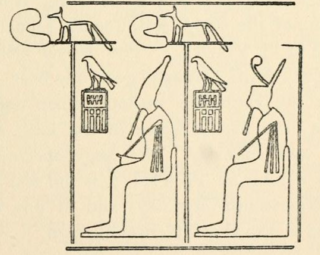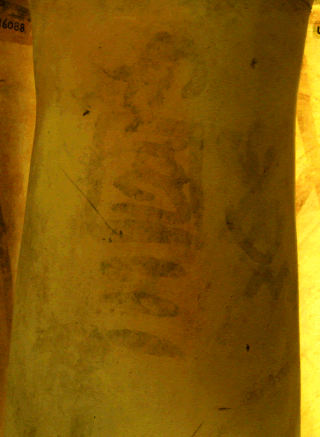Heka was the deification of magic and medicine in ancient Egypt. The name is the Egyptian word for "magic". According to Egyptian literature, Heka existed "before duality had yet come into being." The term ḥk3 was also used to refer to the practice of magical rituals.

The First Dynasty of ancient Egypt covers the first series of Egyptian kings to rule over a unified Egypt. It immediately follows the unification of Upper and Lower Egypt, possibly by Narmer, and marks the beginning of the Early Dynastic Period, when power was centered at Thinis.

Narmer was an ancient Egyptian pharaoh of the Early Dynastic Period, whose reign began at a date estimated to fall in the range 3273–2987 BC. He was the successor to the Protodynastic king Ka. Many scholars consider him the unifier of Egypt and founder of the First Dynasty, and in turn the first king of a unified Egypt. He also had a prominently noticeable presence in Canaan, compared to his predecessors and successors. Neithhotep is thought to be his queen consort or his daughter.
The Early Dynastic Period, also known as Archaic Period or the Thinite Period, is the era of ancient Egypt that immediately follows the unification of Upper and Lower Egypt in c. 3150 BC. It is generally taken to include the First Dynasty and the Second Dynasty, lasting from the end of the archaeological culture of Naqada III until c. 2686 BC, or the beginning of the Old Kingdom. With the First Dynasty, the Egyptian capital moved from Thinis to Memphis, with the unified land being ruled by an Egyptian god-king. In the south, Abydos remained the major centre of ancient Egyptian religion; the hallmarks of ancient Egyptian civilization, such as Egyptian art, Egyptian architecture, and many aspects of Egyptian religion, took shape during the Early Dynastic Period.

Djer is considered the third pharaoh of the First Dynasty of ancient Egypt in current Egyptology. He lived around the mid 31st century BC and reigned for c. 40 years. A mummified forearm of Djer or his wife was discovered by Egyptologist Flinders Petrie, but was discarded by Émile Brugsch.

Hor-Aha is considered the second pharaoh of the First Dynasty of Egypt by some Egyptologists, while others consider him the first one and corresponding to Menes. He lived around the 31st century BC and is thought to have had a long reign.
Nitocris possibly was the last queen of the Sixth Dynasty of Ancient Egypt. Her name is found in writings long considered as relatively accurate resources: a major chronological documentation of the reigns of the kings of ancient Egypt that was composed in the third-century BC by Manetho, an Ancient Egyptian priest and by the ancient Greek historian, Herodotus, in his Histories. She is thought to be the daughter of Pepi II and Neith and to be the sister of Merenre Nemtyemsaf II.

Merenre Nemtyemsaf II was an ancient Egyptian pharaoh, the sixth and penultimate ruler of the 6th Dynasty. He reigned for 1 year and 1 month in the first half of the 22nd century BC, at the very end of the Old Kingdom period. Nemtyemsaf II likely ascended the throne as an old man, succeeding his long-lived father Pepi II Neferkare at a time when the power of the pharaoh was crumbling.

Merneith was a consort and a regent of Ancient Egypt during the First Dynasty. She may have been a ruler of Egypt in her own right, based on several official records. If this was the case and the earlier royal wife Neithhotep never ruled as an independent regent, Merneith may have been the first female pharaoh and the earliest queen regnant in recorded history. Her rule occurred around 2950 BC for an undetermined period. Merneith’s name means "Beloved by Neith" and her stele contains symbols of that ancient Egyptian deity. She may have been Djer's daughter and was probably Djet's senior royal wife. The former meant that she would have been the great-granddaughter of unified Egypt's first pharaoh, Narmer. She was also the mother of Den, her successor.

Iry-Hor was a predynastic pharaoh of Upper Egypt during the 32nd century BC. Excavations at Abydos in the 1980s and 1990s and the discovery in 2012 of an inscription of Iry-Hor in Sinai confirmed his existence. Iry-Hor is the earliest ruler of Egypt known by name and is sometimes cited as the earliest-living historical person known by name.

Helwan is a suburban district in the Southern Area of Cairo, Egypt. The area of Helwan witnessed prehistoric, ancient Egyptian, Roman and Muslim era activity. More recently it was designated as a city until as late as the 1960s, before it became contiguous with the city of Cairo and was incorporated as a district. For a brief period between April 2008 and April 2011 it was redesignated as a city, and served as the capital of the now defunct Helwan Governorate that was split from Cairo and Giza governorates, before being re-incorporated back into them. The kism of Helwan had a population of 521,239 in the 2017 census.

Ka, also (alternatively) Sekhen, was a Predynastic pharaoh of Upper Egypt belonging to Dynasty 0. He probably reigned during the first half of the 32nd century BC. The length of his reign is unknown.
The Thinite Confederacy is an Egyptological term for a hypothesized tribal confederation in ancient Egypt. It is thought to have preceded the full unification of Upper Egypt c. 3100 BC. The leaders of the Thinite Confederacy were most likely tribal nobles. Based at the city of Thinis, the Thinite Confederacy would later be incorporated into the combined state known as "Upper and Lower Egypt".
Neith was an ancient Egyptian queen consort, one of the principal queens of the Old Kingdom pharaoh Pepi II Neferkare, who ruled. Queen Neith was named after goddess Neith.

Neithhotep or Neith-hotep was an ancient Egyptian queen consort who lived and ruled during the early First Dynasty. She was once thought to be a male ruler: her outstandingly large mastaba and the royal serekh surrounding her name on several seal impressions previously led Egyptologists and historians to the erroneous belief that she might have been an unknown king. As the understanding of early Egyptian writings developed, scholars learned that Neithhotep was in fact a woman of extraordinary rank. She was subsequently considered to be the wife of unified Egypt's first pharaoh, Narmer, and the mother of Hor-Aha.
Christiane Kohl is a German soprano in opera and concert.

Double Falcon was a ruler of Lower Egypt from Naqada III. He may have reigned during the 32nd century BC. The length of his reign is unknown.

Crocodile is the provisional name of a predynastic ruler, who might have ruled during the late Naqada III epoch. The few alleged ink inscriptions showing his name are drawn very sloppily, and the reading and thus whole existence of king "Crocodile" are highly disputed. His tomb is unknown.
Hedju Hor was a ruler in northern Egypt from the Predynastic Period. His true existence is unknown. The name Hedju Hor means: The maces of Horus.

Wash was possibly a pharaoh from the Predynastic Period in Ancient Egypt, approximately 5,000 years ago. As Wash is known only through his appearance as a captive of the pharaoh Narmer on the eponymous palette, his existence is contested.














